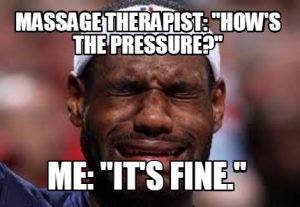Does deep tissue massage have to hurt?
No, deep tissue massage does not have to hurt to be effective.
There’s a common misconception that massage, especially Deep Tissue, must be painful to be effective. So many of us live in the “no pain, no gain” mentality that we think that if it doesn’t hurt, it doesn’t work, but this is entirely false.
First, you have to break down what Deep Tissue Massage is, and honestly, it’s a debated topic, even among massage therapists. Deep Tissue Massage is typically considered any technique meant to affect the deeper layers of muscle and connective tissue. And while some people assume that means applying deep pressure, that’s not the case at all. Some very light touch techniques can affect those deep layers, such as myofascial release. It is a lighter, slower type of bodywork. Still, the effect can be even more significant than what would happen if you were getting your tissues hammered with an elbow (admittedly, if you’re a client of Michigan Massage and Wellness, you’ve probably experienced both).
When faced with the decision of Swedish or Deep Tissue Massage, it’s not about pressure; it’s about the results you hope to achieve. Swedish Massage is generally long fluid strokes, using whatever pressure makes you comfortable, focusing on relaxing the body. Deep Tissue Massage combines several more direct manual techniques, using whatever pressure you’re comfortable with to relieve pain and tension deeper within the body. However, suppose you’ve been to us before. In that case, you know that we don’t even do Swedish but rather a combination of several modalities, each designed specifically for the client on the table. It ends up being an excellent, glorious restorative massage.
The most crucial aspect of your massage is communication. The worst feedback you can give to your massage therapist is no feedback. We want to work with you to develop a treatment plan that will best work for you and your needs and get you on the road to recovery and a maintenance plan as quickly as possible.

Sometimes, especially with Deep Tissue Massage, there might be some discomfort in some tender areas, which is normal. Keep in mind that it should never go beyond a “good hurt,” the kind where it’s uncomfortable, but you can breathe through it, the muscles can stay relaxed, and it’s got a hint of relief mixed in with the hurt. That’s perfectly fine. But if the pressure exceeds that “good hurt” and goes into actual pain, where you make funny faces, hold your breath, or feel like you need to tense up your muscles, that means we’re doing more harm than good.
Whether Swedish, Deep Tissue or any other modality out there, the entire point of your massage is to relax the body and release any built-up tension in the muscles. If you’re clenching or tensing up your muscles in response to something I’m doing, we’re defeating the purpose of your massage, and we need to back off the pressure. So please, no matter what, speak up if the pressure is ever too much or too little. Massage, whatever the type, does not need to hurt to be effective.
In Good Hands,
Rebecca Tamm, LMT
